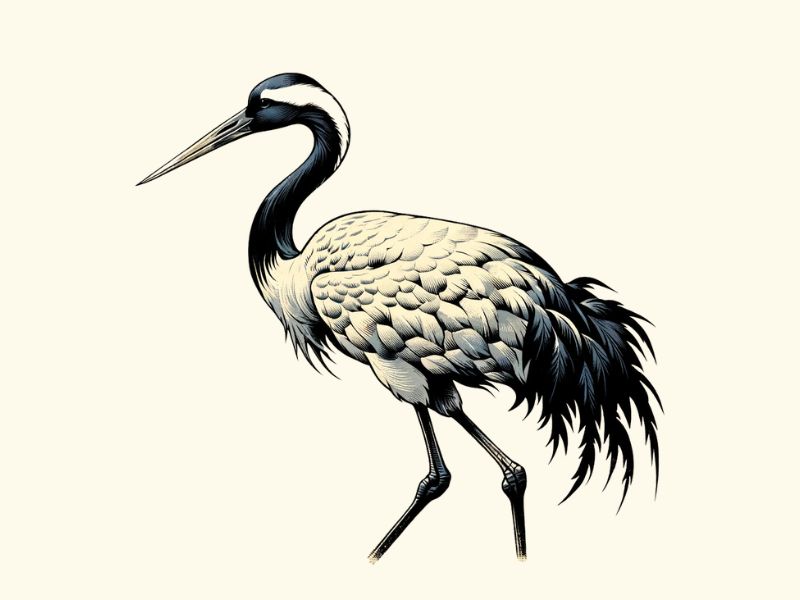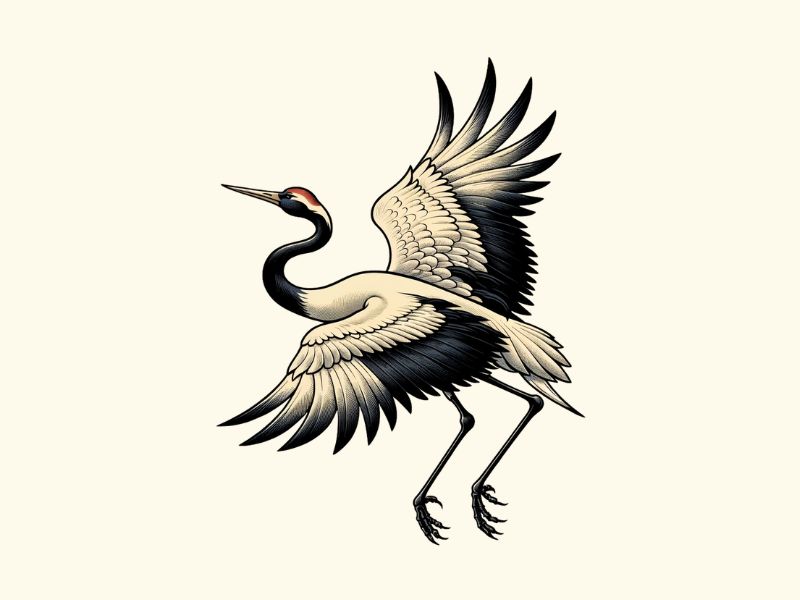
Japanese crane tattoos have been admired for a long time because of how beautiful and elegant they are.
They are often linked to grace, longevity, and good luck.
The revered Japanese crane, a symbol with a deep history in Japanese culture and folklore, is the source of these unique designs.
We’ll talk about what is the Japanese crane tattoos meaning.
In addition, we’ll explore how they relate to traditional Japanese art, and the different Japanese styles and crane tattoo designs that are popular today.
So, let’s spread our wings and learn more about the fascinating world of Japanese crane tattoos.
This post may contain affiliate links. If you click on one of them, we might receive a small commission (at no extra cost to you). Thanks for your support!
Table of Contents
Japanese Crane Tattoo Meaning

The Japanese crane, also called the “red-crowned crane” or “tancho,” is a sign of happiness, good luck, and long life in Japan.
People think that these beautiful birds can live for a thousand years, which makes it a powerful symbol of long life and wealth.
As a result, Grace and Beauty are frequently linked to the Japanese crane tattoo meaning.
Grace and Beauty

The Japanese crane is a very beautiful bird with long legs, a long neck, and beautiful feathers.
Its slow, careful movements and beautiful courtship dance have made it a symbol of grace and beauty in Japan for a long time.
A Japanese crane tattoo can be a reminder to live and act in a way that shows these qualities.
Longevity and Good Health

People in Japan believe that cranes can live for a thousand years, which makes them powerful symbols of long life and good health.
Some Japanese legends also say that the crane can live forever, which adds to the idea that it can live a long time.
A Japanese crane tattoo can be a wish for the wearer or a loved one to be healthy and live a long, happy life.
Good Fortune and Prosperity

People in Japan often think of the crane as a symbol of good luck and wealth.
People think that being around a crane or seeing one in the wild will bring them luck and success.
So, a Japanese crane tattoo can mean that you want plenty and success in many areas of your life, like your career, your relationships, and your own growth.
Loyalty and Commitment in Relationships

Loyalty and Commitment in Relationships.Cranes are known to stay with the same partner for life, which makes them a symbol of commitment and loyalty in relationships.
A Japanese crane tattoo can show that the person is committed to their partner and wants to be in a loving relationship for a long time.
This tattoo can also be a reminder to stay true to one’s own values and keep working on personal growth and self-improvement.
Resilience and Overcoming Challenges

The Japanese crane is a migratory bird that often has to fly long distances to get to where it breeds.
This hard journey takes strength and patience, which is why the crane is a symbol of strength and the ability to get through hard times.
A Japanese crane tattoo can serve as a reminder to stay strong and keep going through hard times.
This is because the crane never gives up.
The Paper Crane and Sadako Sasaki

The story of Sadako Sasaki, a young girl who became a symbol of hope and peace after the atomic bombing of Hiroshima, has added to what the Japanese crane tattoo means.
Sadako got leukemia after being exposed to radiation, and while she was getting treatment, she started folding paper cranes.
She was inspired to do this by a Japanese legend that says if you make 1,000 origami cranes, your wish will come true.
Sadako’s story still moves people all over the world, even though she has passed away.
The paper crane has become a symbol of hope, peace, and healing, which you can see in Japanese crane tattoos.
The Art of Japanese Crane Tattoos

Japanese crane tattoos are often made with a mix of old and new tattooing styles, like Irezumi and Tebori.
This makes a form of art that is both unique and beautiful to look at. It honors both the past and the present.
Some of the most common parts of Japanese crane tattoos are:
- Traditional Japanese art and motifs, such as cherry blossoms, waves, and wind bars
- Other Japanese tattoo symbols, like koi fish, dragons, and snakes
- Incorporation of Japanese folklore and mythology
- The use of black ink, as well as colorful and vibrant hues
- Combining the crane with origami or paper crane designs
Traditional Japanese Tattooing Techniques
Irezumi and Tebori are old ways of getting tattoos in Japan that have been used for hundreds of years.
Irezumi is the art of making intricate designs by hand with a special brush.
Tebori is the art of tattooing by hand with needles attached to a wooden or metal tool.
Skilled tattoo artists still use both of these techniques, and they often combine them with modern tattoo machines to make beautiful Japanese crane tattoos.
Irezumi: How Crane Tattoos Came to Be

The ancient Japanese art of tattooing, called Irezumi, is where the history of crane tattoos can be found.
Irezumi has been around since the Jomon period (10,000 B.C. to 300 B.C. ), which is a long time ago.
But the art really took off during the Edo period (1603-1868), when many of the traditional Japanese tattoo designs we know today, like the crane, became popular.
Japanese cranes have been a part of Japanese art for a long time.
They show up in paintings, woodblock prints, and fabrics.
Cranes were often shown in these ways because they stood for things like grace, longevity, and good luck.
As Irezumi became more popular, cranes became a popular motif in Japanese tattoos.
This is because cranes have a lot of meaning in other kinds of art.
Tebori: Japanese Tattooing Technique

Traditional Japanese tattoos are known for their strong black lines and bright colors.
In particular, the crane is often shown with its distinctive red crown and white and black feathers, which make for a striking image.
Traditional Japanese tattoos are known for their color and their intricate, detailed designs, which show how skilled and precise the tattoo artist is.
Tebori is a hand-poked tattooing method that is used in traditional Japanese tattooing.
This is something that makes it stand out. In this method, ink is put into the skin by hand using a wooden or metal tool with a set of needles on the end.
Tebori tattoos look different from machine tattoos because the colors are more vivid and have more texture.
Many modern Japanese tattoo artists still use Tebori, so you can get a traditional and authentic Japanese crane tattoo.
Japanese Crane Tattoo Ideas

Japanese crane tattoos let you show how unique and creative you are in a lot of different ways. Here are some suggestions to help you get started:
- A black ink drawing of a simple, minimalist crane.
- A Japanese crane in the air, with cherry blossoms all around.
- A colorful and complicated Japanese crane tattoo with elements of traditional Japanese art
- A crane and an origami crane together, which stands for peace and hope.
- A full-length sleeve or back piece with a detailed scene of a Japanese crane.
- A pair of cranes, which stand for love and loyalty in relationships.
- A Japanese crane tattoo with special calligraphy or kanji characters for you
- A pattern that combines the Japanese crane with other important symbols, like koi fish or dragons.
- A tattoo with paper cranes and the sign for peace that honors Sadako Sasaki and her story of hope.
- A crane tattoo that looks like traditional Japanese paintings or woodblock prints, showing off Japan’s long history of art.
FAQs About Japanese Crane Tattoos

What does a Japanese crane tattoo mean?
Japanese crane tattoo has a lot of meanings that come from Japanese culture and mythology.
The meanings of a Japanese crane tattoo include grace and beauty, long life and good health, luck and wealth, loyalty and commitment in relationships, and the strength to get through hard times.
Because of these good things, the Japanese crane tattoo is often chosen by people who want a tattoo with deep cultural roots and personal meaning.
What do crane tattoos mean?

In general, crane tattoos have a lot of different meanings in different cultures.
Crane tattoos are a sign of grace, beauty, longevity, good health, luck, loyalty, and strength in Japanese culture.
Cranes may be seen as signs of wisdom, balance, and spiritual growth in other cultures.
The exact meaning of a crane tattoo can change based on the culture it comes from and how the person sees it.
How do I choose the right Japanese crane tattoo for me?

Start by looking into the different styles and designs of Japanese crane tattoos to find one that speaks to you.
Think about what the crane means to you and how it relates to your own experiences and values.
Talk to a skilled tattoo artist, preferably one who has done Japanese tattoos before, about how to make your idea come to life.
How do I find a tattoo artist who specializes in Japanese crane tattoos?
Look up good tattoo shops in your area or online and look through their artists’ portfolios to find someone who specializes in Japanese tattoos, especially Japanese bird tattoos.
Look at their work for examples of Japanese crane tattoos, and don’t be afraid to ask for suggestions or read reviews.
Can I combine my crane tattoo with other Japanese symbols or elements?

Absolutely! You can add other things to a Japanese crane tattoo, like cherry blossoms, koi fish, dragons, or even Japanese calligraphy.
The key is to make a design that works well together and looks good, but also has meaning for you.
Will getting a Japanese crane tattoo hurt?
The pain of getting a tattoo depends on how well you can handle pain, the size and complexity of the design, and where the tattoo is put.
Talk to your tattoo artist about your worries.
They can help you get ready and give you tips for dealing with pain during the process.
Japanese Crane Tattoo Meanings for You

Japanese crane tattoos are beautiful and have deep symbolism.
They have a long cultural history and allow people to be creative and express themselves.
A Japanese crane tattoo can be a beautiful and meaningful addition to your body art.
There are many different designs and styles to choose from. If you know what the crane means to you, try out different design ideas, and find a good tattoo artist, you can make a powerful and unique tattoo that will last for a long time.
Embrace the grace and beauty of the Japanese crane and watch your tattoo soar to new heights.
Please note that the information on tattoo meanings in this blog is for general guidance only and not a substitute for professional advice. Tattoo symbolism can vary greatly, and we recommend consulting with qualified experts to understand the significance and appropriateness of any design before proceeding.

